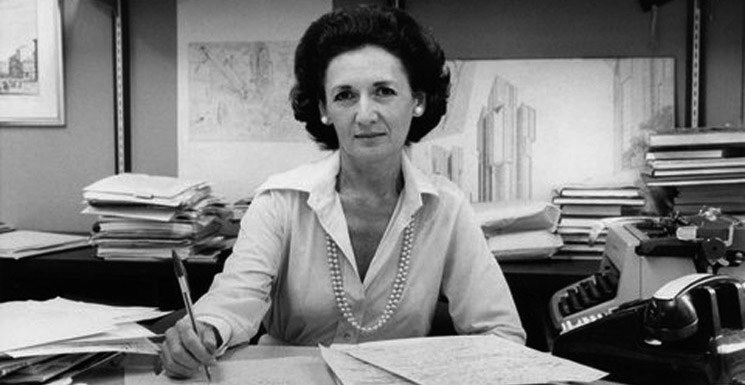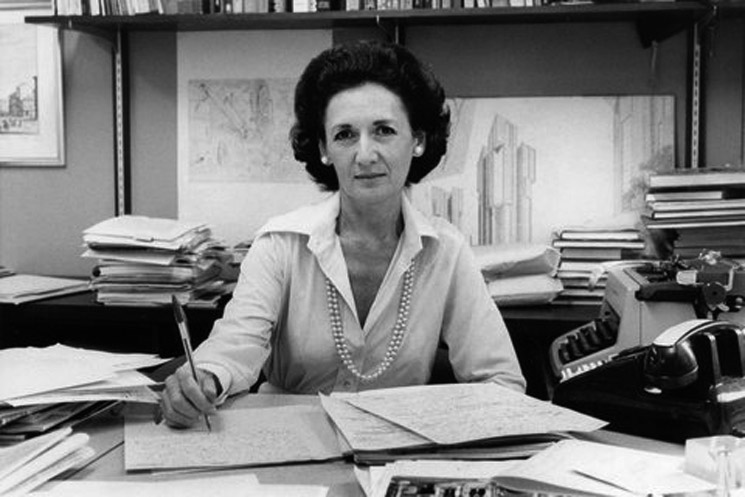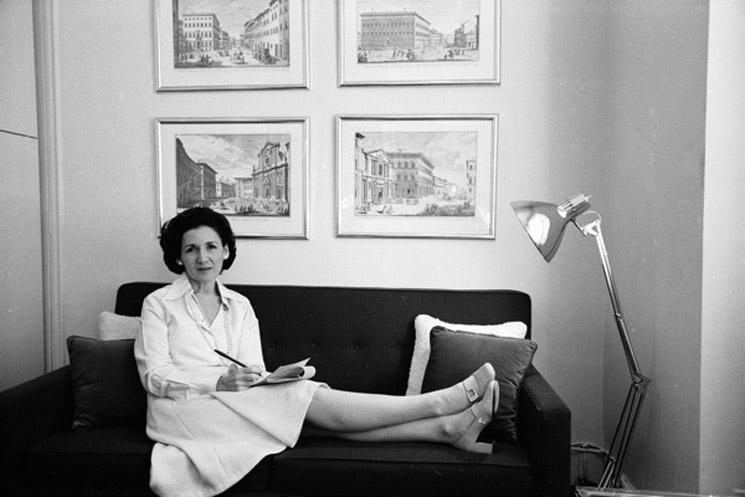Casa manifiesto
El primer manifiesto en México se escribió en 1921. Anuncios, carteles y publicaciones como Irradiador e Urbe consumaron la vanguardia [...]
9 enero, 2013
por Juan José Kochen | Twitter: kochenjj

La arquitectura también se escribe y los edificios también se leen. Ada Louise Huxtable (1921-2013) murió el 7 de enero de 2013 a los 91 años de edad. Estudió en New York University’s Institute of Fine Arts y durante cuatro años (1946-1950) fue asistente de curaduría en el Museum of Modern Art (MoMA) neoyorquino. En su primer artículo para The New York Times Magazine, publicado en 1958, criticaba cómo los periódicos cubrían el desarrollo y crecimiento urbano de las ciudades: “Architecture is the stepchild of the popular press” terminaba su aforismo. Sus textos siguieron la línea de críticos e historiadores como Mariana Van Renssalaer, Esther McCoy, Aline B. Saarinen, Anne O’Hare McCormick, Lewis Mumford y Montgomery Schuyler.
Comenzó en 1963 escribiendo para The New York Times y terminó ‘criticando’ para The Wall Street Journal; su último texto, Undertaking Its Destruction, publicado el 3 de diciembre del año pasado, fue una crítica frontal al proyecto de actualización para la Biblioteca Pública de Nueva York a cargo de Foster & Partners: “You don’t “update” a masterpiece. “Modernization” may be the most dangerously misused word in the English language”. En 1970, Huxtable fue la segunda mujer en ganar un Pulitzer para The New York Times, 33 años después que McCormick. En 1981, cuando Huxtable salió del diario americano, el texto editorial suscribió que ella misma había inventado una nueva profesión y que simplemente había cambiado la forma en que los lectores veían y pensaban los espacios de su entorno construido.
Como un manual de usuario para leer y entender la ciudad, Huxtable escribía los textos de su columna para develar los edificios, parques, tránsitos y las demoras de Manhattan. Sin conjeturas, escribía sobre la experiencia de habitar y percepción de los espacios. En 1996, Paul Goldberger –sucesor de Huxtable como crítico de The New York Times, ahora editor de Vanity Fair– escribió que antes de Ada Louise Huxtable la arquitectura no era parte de un diálogo público. Huxtable entabló este diálogo con relatos y crónicas asiduas sobre la evolución de la ciudad vertical y sus rascacielos. Como crítica a su crítica, de la misma forma en que Luis Fernández-Galiano lo hace en el prólogo de Por qué importa la arquitectura, la edición español de Why Architecture Matters de Paul Goldberger, Huxtable sólo escribía de su realidad, de su entorno inmediato: Lever House, Ford Foundation Building, CBS Building, Bronx Grit Chamber, Boston’s City Hall, National Gallery of Art, Pennzoil Place; y entre líneas mostraba su afinidad por un selecto grupo de arquitectos como Le Corbusier, Walter Gropius, Mies van der Rohe, Frank Lloyd Wright, Paul Rudolph, Louis I. Kahn, Eero Saarinen, Frank Gehry, Álvaro Siza, Rafael Moneo, Jean Nouvel o Christian de Portzamparc.

En 2008, The Architectural League le otorgó la President’s Medal, galardón que también ha sido entregado a Richard Meier, Robert A.M. Stern, Kenneth Frampton, Tod Williams y Billie Tsien, y a Robert Venturi y Denise Scott Brown. Además de haber escrito para The New York Times, Wall Street Journal y New York Review of Books, Huxtable escribió once libros: Four Walking Tours of Modern Architecture in New York City (1961), Classic New York: Georgian Gentility to Greek Elegance (1964), Kicked a Building Lately? (1976), The Tall Building Artistically Reconsidered: The Search for a Skyscraper Style (1984), Goodbye History, Hello Hamburger (1986), The Unreal America: Architecture and Illusion (1997) y On Architecture: Collected Reflections on a Century of Change (2008), entre los más destacados.
En este último que reúne una selección de su colección de textos, se retoman estas frases que acompañaron su discurso periodístico-crítico-arquitectónico. Sin duda resulta mejor leer las ideas con el mismo énfasis, literalidad y palabras de su construcción original, en inglés. Huxtable escribe sobre la preservación de la ciudad, su textura y capas de distintos significados históricos. En ese sentido, la ciudad y la escritura mantienen una liga perdurable que implica el compromiso de establecer una mediación entre el lector, el espacio arquitectónico y su ubicación respecto del mismo. Esta relación de la arquitectura con quien (des)escribe su condición estética es la coexistencia efímera de un espacio “literario” y otro arquitectónico.
En La estructura de las revoluciones científicas, Thomas Khun decía que un texto es una construcción que se va armando con ladrillos y que desde el lenguaje se le dan los acabados. La arquitectura, con o sin acabados, se construye desde su inserción en la ciudad. No sólo tiene una función formal y utilitaria, sino que debe contar una buena historia, mostrar una imagen reconocible o crear un edificio icónico. La afinidad de este binomio, más allá de narrar un Periodismo arquitectónico, definido así por Manuel Larrosa en su compilación de crónicas urbanas, se remite a la construcción de los edificios donde se han escrito los avatares de las ciudades.

When it is good, this is a city of fantastic strength, sophistication and beauty. It is like no other city in time or place. Visitors and even natives rarely use the words urban character or environmental style, but that is what they are reacting to with awe in the presence of massed, concentrated, steel, stone, power and life.
Buildings change; they adapt to needs, times and tastes. Old buildings are restored, upgraded and converted to new uses. For architecturally or historically significant buildings with landmark protection, the process is more complex; subtle, subjective and difficult decisions are often required. Nothing, not even buildings, stands still.
A building is not a studio work; it is the product of an enormous mixed bag of programs and pressures that go far beyond the unified vision that is possible for the creator, performer, interpreter or translator of other art forms. It is caught in an endless struggle between the aesthetic and the pragmatic on a battlefield of politics, money and power.
I wish people would stop asking me what my favorite buildings are. I do not think it really matters very much what my personal favorites are, except as they illuminate principles of design and execution useful and essential to the collective spirit that we call society. I was writing at a historic moment, observing an amazing century of change, documenting an architectural revolution, watching a remarkable scenario unfold.
The theme that runs through all of this writing is the transformation of the modernism that pervaded every intellectual and cultural aspect of the twentieth century into a new way of thinking and building.
Architecture is the stepchild of the popular press. Important architectural change is not an instinctive or unpremeditated act; in all of this work, theory has a significant, if questionable, role. Architects tend to be coattail philosophers, adopting and bowdlerizing intellectual trends as they go out of style. Theory can redefine architecture or derail it.
Art elevates the experience and pleasure of the places where we live and work. As critics, we do our best to explain and uphold those standards and to hold faulty feet to fire. As journalists, we report news, which runs the risk of instant obsolescence. Architecture is the art that absolutely cannot be avoided, [the art] that expresses everything that any civilization creates or leaves behind it.
Every age cuts and pastes history to suit its own purposes; art always has an ax to grind. Architecture is remaking our world. It is important to understand how and why this is happening if we are to be beneficiaries, rather than casualties, of the process. Its rewards are personal and universal in a way no other art can match. Its joys are common to us all.

El primer manifiesto en México se escribió en 1921. Anuncios, carteles y publicaciones como Irradiador e Urbe consumaron la vanguardia [...]
En 1951, Kaspé publicó 'El paseo de un arquitecto' con la finalidad de “dar a conocer algunas obras arquitectónicas de [...]